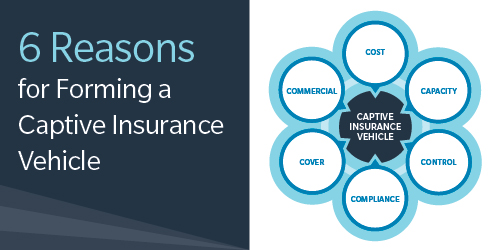The Six Cs of Captive Value: Focus on Cost
As the use of big data and analytics in risk financing and insurance decision making increases, the benefits of retaining risk are easier to assess and quantify. Once the amount of risk to transfer via insurance has been determined, the next step is to evaluate how best to finance the risks your company chooses to retain. For some companies, a captive insurance vehicle provides the financial, strategic, and operational benefits they seek. For others, their current or other risk financing methodologies will be more appropriate.
Companies establish captive insurance vehicles for various reasons depending on their industries and geographies. A captive insurance vehicle can create value in the following areas:
- Financial — Reduce cost of risk by capturing profitable premium that would otherwise be paid to commercial insurers. There can also be tax efficiencies from pre-funding losses in a formal vehicle.
- Strategic — Improve group purchasing power, control customer, supplier, or employee insurance costs, and provide direct access to reinsurance market capacity.
- Operational — Centralize control of insurance, capture underwriting and performance management data, and improve group control of claims.
Reasons for Forming a Captive Insurance Vehicle — The Six Cs

There are six principal considerations in forming the captive insurance vehicles. Here we focus on the first C, cost. In future articles we will address the other five: capacity, control, compliance, cover, and commercial.
The strategic and operational benefits of a captive insurance vehicle should not be overlooked, but can be difficult to assess, as value often differs among stakeholders and from company to company. Fortunately, the financial value of a captive can be easier to quantify.
The graphic below illustrates how a captive insurance vehicle can create financial value. The chart shows the component parts of cost of risk for the following options:
- Obtaining conventional insurance from a third-party insurer.
- Retaining some of the risk “on balance sheet“ and purchasing insurance above a tolerable limit.
- Retaining a portion of the risk in a captive insurance vehicle and purchasing insurance above a tolerable limit.

In the above illustration, the captive insurance company has the lowest cost of risk and is therefore the most efficient risk financing strategy.
Retaining risk in a captive and “on balance sheet“ enables the group to retain profitable premium that would otherwise go to a third-party insurer. However, the captive is able to capture a greater proportion of the third-party premium because it is a formalized insurance vehicle and complies with the group’s contractual and statutory obligations to have insurance. Retaining these risks on balance sheet is unlikely to be acceptable to external stakeholders, so the group must purchase additional third-party insurance coverages to meet these obligations.
The path to a captive insurance vehicle starts with a feasibility study to access the business case, including the financial, strategic, and operational benefits and limitations of alternative risk financing methodologies. If it is determined that a captive vehicle would benefit your organization, Marsh Captive Solutions, with your tax and accounting teams, can help you to determine the setup that meets the unique needs of your organization.
